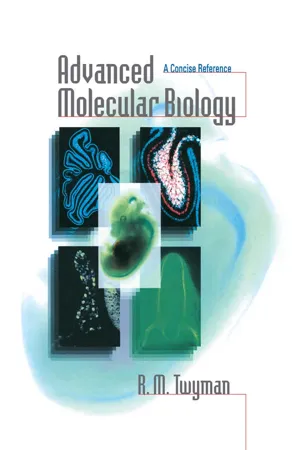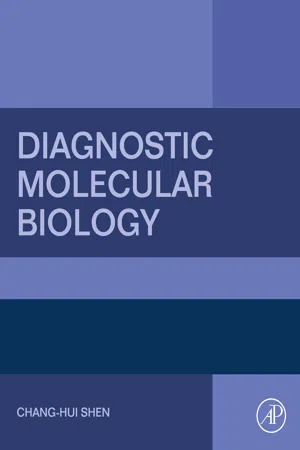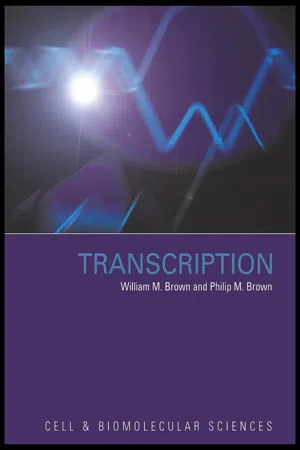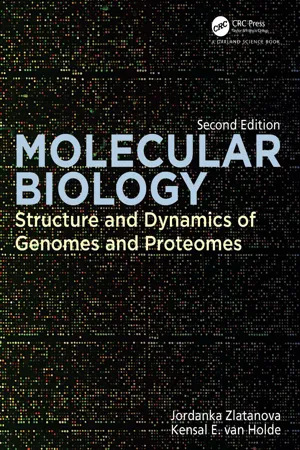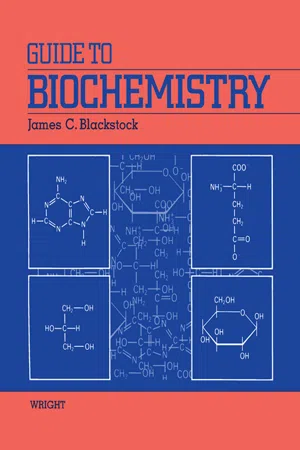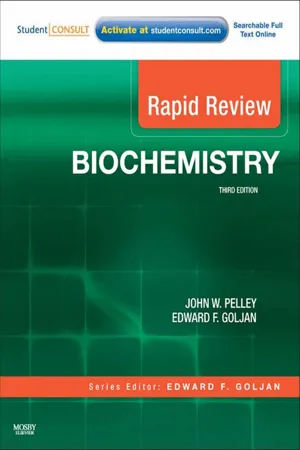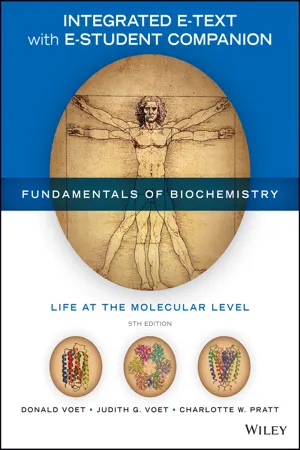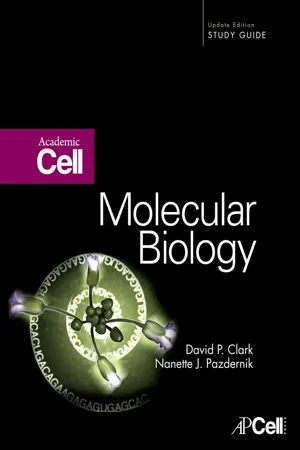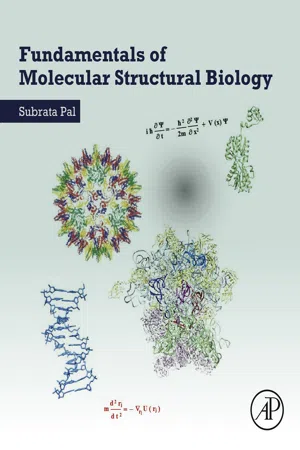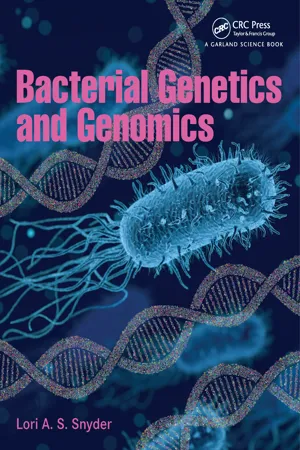Biological Sciences
Transcription and Translation in Prokaryotes
Transcription in prokaryotes is the process of synthesizing RNA from a DNA template, carried out by RNA polymerase. Translation is the process of converting the information in RNA into a sequence of amino acids to form a protein. In prokaryotes, both transcription and translation occur in the cytoplasm, allowing for simultaneous gene expression and protein synthesis.
Written by Perlego with AI-assistance
Related key terms
11 Key excerpts on "Transcription and Translation in Prokaryotes"
- eBook - ePub
Advanced Molecular Biology
A Concise Reference
- Richard Twyman(Author)
- 2018(Publication Date)
- Garland Science(Publisher)
Chapter 29Transcription
Fundamental concepts and definitions- Transcription is the synthesis of RNA using DNA as a template. In vivo, transcription is the first level of gene expression and the predominant level of gene regulation. Additionally, RNA primers for cellular DNA replication are generated by transcription, and transcription plays a major role in the replication cycle of the retroid viruses (q.v.). The components of several bacterial and eukaryotic transcription systems have been defined, allowing the in vitro transcription, and coupled in vitro transcription and translation of cloned genes.
- Unlike DNA replication (q.v.), transcription is asymmetric — only one strand of the DNA is used as a template (Figure 29.1 ). The nascent RNA is analogous to the leading strand (q.v.) in DNA replication, i.e. it is transcribed continuously. Each RNA molecule is a transcript, and the region of DNA from which it was transcribed is a transcription unit (q.v. gene, cistron, operon). The first nucleotide in the transcript is defined as position +1 of the transcription unit. The nucleotide immediately preceding this on the corresponding DNA strand is defined as position –1; there is no position 0.
- Enzymes which catalyze transcription are termed (DNA-dependent) RNA polymerases. Unlike DNA polymerases, RNA polymerases initiate strand synthesis de novo (i.e. without primers) and do not proofread their transcripts (see Box 26.1 ).
- Successful transcription requires RNA polymerase to be recruited to a cis-acting promoter
- eBook - ePub
- Chang-Hui Shen(Author)
- 2019(Publication Date)
- Academic Press(Publisher)
Chapter 3Gene Expression: Transcription of the Genetic Code
Abstract
The central dogma of molecular biology is that DNA makes RNA, and RNA makes proteins. This process is called gene expression, and the genetic information is used within a cell to produce the proteins needed for the cell to function. The process of making RNA from DNA is transcription, a process of RNA biosynthesis. It is the first step in gene expression, and it is a vital control point in the expression of genes and production of proteins. In this process, one of the strands of the double-stranded DNA molecule (a template strand) is transcribed into a complementary sequence of RNA. The RNA sequence differs from DNA in three respects: (1) the DNA base thymine (T) is replaced by the RNA base uracil (U); (2) the sugar ring of RNA has a hydroxyl group in the 2′-position, whereas the sugar ring of DNA has a hydrogen group in the 2′-position; and (3) DNA exists as double helix, whereas RNA is single stranded. In this chapter, we discuss the mechanism of transcription in both prokaryotes and eukaryotes. Different types of RNA are also discussed in this chapter. - Tina M. Henkin, Joseph E. Peters(Authors)
- 2020(Publication Date)
- ASM Press(Publisher)
2 Bacterial Gene Expression: Transcription, Translation, Protein Folding, and Localization- Overview
- The Structure and Function of RNA
- Types of RNA
- RNA Precursors
- RNA Structure
- RNA Processing and Modification
- Transcription
- Structure of Bacterial RNA Polymerase
- Overview of Transcription
- Details of Transcription
- rRNAs and tRNAs
- RNA Degradation
- RNases
- The Structure and Function of Proteins
- Protein Structure
- Translation
- Structure of the Bacterial Ribosome
- Overview of Translation
- Details of Protein Synthesis
- The Genetic Code
- Polycistronic mRNA
- Protein Folding and Degradation
- Protein Chaperones
- Protein Degradation
- Protein Localization
- The Translocase System
- The Signal Sequence
- The Targeting Factors
- The Tat Secretion Pathway
- Disulfide Bonds
- Protein Secretion and Export
- Protein Secretion Systems in Bacteria with an Outer Membrane
- Protein Secretion in Bacteria That Lack an Outer Membrane
- Sortases
- Regulation of Gene Expression
- Transcriptional Regulation
- Posttranscriptional Regulation
- What You Need To Know
- Open Reading Frames
- Transcriptional and Translational Fusions
- BOX 2.1 Antibiotic Inhibitors of Transcription
- BOX 2.2 Molecular Phylogeny
- BOX 2.3 Antibiotic Inhibitors of Translation
- BOX 2.4 Mimicry in Translation
- BOX 2.5 Exceptions to the Code
Fluorescence of transformants expressing MBP-GFP hybrid proteins. MC4100 transformed with the following: 1, pMGP2; 2, pMGC2; 8, MM52 [secA(Ts)] transformed with pMGP2; 3, pMGC2; 7, CK2163 (secB) transformed with pMGP2; 4, pMGC2; 6, IQ85 [secY(Ts)] transformed with pMGP2; and 5, pMGC2. From Feilmeier et al. 2000 (see Suggested Reading).UNCOVERING THE MECHANISM OF PROTEIN SYNTHESIS , and therefore of gene expression, was one of the most significant accomplishments in the history of science. The process of gene expression is called the central dogma- eBook - ePub
- William M. Brown, Philip M. Brown(Authors)
- 2001(Publication Date)
- CRC Press(Publisher)
2Transcription, The Process
- Overview
- The transcriptional process
- Post-transcriptional processing of eukaryotic mRNA
- Transcription and translation occur simultaneously in prokaryotes
- Sequence-specific DNA-binding proteins or “transcription factors”
OBJECTIVES- introduce the three steps in the transcriptional process
- introduce other processes that occur co-transcriptionally or posttranscriptionally
1.OVERVIEW
The process of transcription can be thought of as a three-step process: initiation, elongation, and termination of the RNA transcript. Logically and economically, the major control point ought to be at the first step of the process, that of initiation. It is therefore not surprising that this is exactly where the cell primarily regulates transcription, but it is not the only point. In the eukaryotic cell, further levels of control are possible via mRNA processing (capping, tailing, and splicing), mRNA transport (out of the nucleus to the ribosomes), mRNA degradation, and protein translation at the ribosome.2.THE TRANSCRIPTIONAL PROCESS
An operon is a set of functionally related genes under a common control mechanism, commonly found in bacteria.There are three primary steps in the process of transcription: initiation, elongation, and termination of the RNA transcript. Initiation involves assembling a multi-protein complex on a gene’s promoter, upstream of the transcriptional start site. Elongation involves the complex moving down the DNA strand, “copying” -by base pairing-the DNA into RNA. Termination involves the complex recognising the end of the gene or operon and disassembling.3.POST-TRANSCRIPTIONAL PROCESSING OF EUKARYOTIC MRNA
Transcription is a three-step process: initiation, elongation, and termination.In eukaryotes, in addition to the transcription process itself, there is much processing of the nascent RNA transcript (sometimes referred to as hnRNA, heterogeneous nuclear RNA) before it passes to the cytoplasm for translation at the ribosome. Eukaryotic mRNA has a long half-life, is monocistronic (i.e., - eBook - ePub
Molecular Biology
Structure and Dynamics of Genomes and Proteomes
- Jordanka Zlatanova(Author)
- 2023(Publication Date)
- Garland Science(Publisher)
Transcription in BacteriaDOI: 10.1201/9781003132929-9Learning objectivesTranscription is the process whereby the sequence of DNA is copied into an RNA sequence. The newly synthesized RNA strand is complementary to one DNA strand and is thus identical to the other DNA strand. Transcription is catalyzed by enzymes called RNA polymerases (RNAPs). The RNAP pulls DNA through itself to synthesize RNA chains starting from the 5′-end toward the 3′-end.Transcription is initiated at a defined start site, which is part of the so-called promoter region. In bacteria, recognition of the promoter requires special σ subunits that are complexed with the multisubunit RNAP core complex. RNAP binding to the promoter opens a bubble in the DNA duplex, allowing the initiation of transcription. In the next phase, elongation, the polymerase moves processively over long stretches of DNA but may pause from time to time. We discriminate short pauses from long pauses; in the latter, the proper placement of the 3′-end of the nascent RNA transcript in the bubble is lost, which requires special treatment. Elongation causes accumulation of superhelical stress in the DNA template, inhibiting transcription. Special enzymes, topoisomerases, play a role in relaxing the DNA superhelical stress; in addition, the presence of multiple RNAPs on frequently transcribed regions largely negates inhibition by superhelical stress. The final phase, termination, can occur via several kinds of mechanisms. Sequence-specific termination requires special sequences at the 3′-end of the transcript that favor hairpin formation followed by release of the transcript. In other cases, termination is produced by a helicase enzyme, which recognizes a site on the nascent transcript, moves along the RNA chain toward the polymerase, and literally pulls the RNA chain out of the polymerase.9.1 Introduction
As we have seen in previous chapters, the genetic information in the cell is stored in DNA. But this information is expressed in the form of specific RNA and protein molecules. In fact, all this expression requires the synthesis of RNA molecules that are complementary in sequence to one of the two strands of DNA. The process of RNA synthesis, or transcription, is an essential part of both production of mRNA templates for protein synthesis and generation of all the special RNA molecules needed in the cell. In this chapter, we first provide an overview of the basic mechanisms common to transcription in all organisms and then present a more detailed picture as to how transcription occurs in bacteria. Further aspects of the regulation of transcription in bacteria will be covered in Chapter 11 - eBook - ePub
- James C. Blackstock(Author)
- 2014(Publication Date)
- Butterworth-Heinemann(Publisher)
CHAPTER 17Gene expression
Publisher Summary
This chapter presents the concept of gene expression. The concept of the central dogma of molecular biology, formulated in the late 1950s by Francis Crick may be summarized as DNA (deoxyribonucleic acid) →RNA (ribonucleic acid) →protein. Transcription is the process in which RNA is synthesized by enzymes called DNA-directed RNA polymerases. These enzymes use ribonucleoside triphosphates as substrates and DNA as a template. Specific base sequences signal the termination of transcription. Transcription produces RNA molecules. Translation involves two compartments: the cytosol in which individual amino acids are enzymically attached to their specific tRNAs by amino-acid-tRNA ligases and the ribosomes in which the amino acids are correctly positioned according to the base sequence of a mRNA template and polymerized into polypeptide chains. As there are four major bases in mRNA, 43 different codons are possible. The 64 triplets constitute the genetic code. The genetic code applies to prokaryotes and eukaryotic nuclear and chloroplast mRNAs but not to mitochondrial mRNAs. Therefore, the genetic code is quasi-universal.17.1 The central dogma
The concept of the central dogma of molecular biology (Section 1.6 ), formulated in the late 1950s by Francis Crick may be summarized as DNA (deoxyribonucleic acid) → RNA (ribonucleic acid) → protein.In all living organisms, nuclear DNA serves as the reservoir of genetic information which is expressed in terms of the structure of proteins manufactured by the cell. The base sequence of the DNA determines the amino acid sequence of proteins which are responsible for all aspects of cellular function. Because of cellular organization, synthesis of protein from the DNA blueprint occurs in two stages: transcription, i.e. the synthesis of a messenger RNA molecule of a structure complementary to the structure of DNA so that the genetic information is transferred to mRNA, and upon delivery of the message to the cytosol, its translation into protein. - eBook - ePub
Rapid Review Biochemistry
Rapid Review Biochemistry E-Book
- John W. Pelley, Edward F. Goljan(Authors)
- 2010(Publication Date)
- Mosby(Publisher)
Chapter 12 Gene ExpressionI. RNA transcriptionA. Overview1. RNA is a single-stranded molecule that often contains internal base-paired regions, forming stem loops.2. Bacteria have one RNA polymerase, and eukaryotes have three. 3. Prokaryotic mRNA is synthesized as a final product, but eukaryotic mRNA is synthesized as a primary transcript that must be further processed to remove introns. 4. Prokaryotic and eukaryotic genes have promoter regions that point RNA polymerase in the right direction and position it to start transcribing at the correct nucleotide base.RNA: single-stranded polynucleotide synthesized by RNA polymeraseB. Types of RNA1. The three major types of RNA have specific functions in protein synthesis.a. Messenger RNAs (mRNAs) provide the blueprint for an amino acid sequence; mRNA is about 5% of total RNA.tRNA: high degree of secondary structure; three base anticodon, acceptor arm for amino acid attachmentb. Transfer RNAs (tRNAs) match genetic information to an amino acid sequence; tRNA is about 15% of total RNA.c. Ribosomal RNAs (rRNAs) self-assemble with basic proteins to form ribosomes; rRNA is about 80% of total RNA.(1) tRNAs have a cloverleaf shape with an acceptor arm, which receives the amino acid, and a three-base anticodon, which can form base pairs with the complementary codon in mRNA.mRNAs are the blueprints for protein synthesis; tRNAs match codons to amino acids; and rRNAs contribute to ribosome structure. - eBook - ePub
Fundamentals of Biochemistry, Integrated E-Text with E-Student Companion
Life at the Molecular Level
- Donald Voet, Judith G. Voet, Charlotte W. Pratt(Authors)
- 2017(Publication Date)
- Wiley(Publisher)
CHAPTER 26 Transcription and RNA ProcessingChapter Contents
- Prokaryotic RNA Transcription
- RNA Polymerase Resembles Other Polymerases
- Transcription Is Initiated at a Promoter
- The RNA Chain Grows from the 5′ to 3′ End
- Transcription Terminates at Specific Sites
- Transcription in Eukaryotes
- Eukaryotes Have Several RNA Polymerases
- Each Polymerase Recognizes a Different Type of Promoter
- Transcription Factors Are Required to Initiate Transcription
- Posttranscriptional Processing
- Messenger RNAs Undergo 5′ Capping and Addition of a 3′ Tail
- Splicing Removes Introns from Eukaryotic Genes
- Ribosomal RNA Precursors May Be Cleaved, Modified, and Spliced
- Transfer RNAs Are Processed by Nucleotide Removal, Addition, and Modification
Saheli: Chowdhury, Christophe Maris, Frédérick H-T Allain, and Franz Narberhaus, EMBO J, 25, 2487–2497 (2006)Certain bacteria alter gene expression by using an RNA thermometer, a base-paired messenger RNA segment whose conformation is disrupted when the temperature rises. RNA melting exposes a ribosome-binding site, allowing production of the encoded protein, which is often a heat shock protein that helps the bacteria survive at the higher temperature.DNA is confined almost exclusively to the nucleus of eukaryotic cells, as shown by microscopists in the 1930s. By the 1950s, the site of protein synthesis was identified by showing that radioactively labeled amino acids that had been incorporated into proteins were associated with cytosolic RNA–protein complexes called ribosomes. Thus, protein synthesis is not immediately directed by DNA because, at least in eukaryotes, DNA and ribosomes are never in contact. The intermediary between DNA and the protein-biosynthesis machinery, as outlined in Francis Crick's central dogma of molecular biology (Section 3-3B - eBook - ePub
Molecular Biology
Academic Cell Update Edition
- David P. Clark(Author)
- 2012(Publication Date)
- Academic Cell(Publisher)
9 Regulation of Transcription in ProkaryotesSummary
Understanding gene regulation, albeit complicated, is the crux of molecular biology. In the central dogma, the prevailing theory is that DNA → RNA → protein and replication maintains the DNA code from generation to generation, but these events cannot occur at random. Gene regulation controls when and where the DNA is expressed into protein. The question is what genes, at what time, and at what amount. Gene regulation can occur by controlling how much RNA is made from DNA, how much protein is made from RNA, and how the protein works. This chapter focuses on mechanisms controlling the amount of RNA expressed from DNA.Prokaryotes typically have positive and negative regulation that turns genes on, or keeps genes off until the moment is right. Transcriptional regulation in general can affect RNA polymerase’s access to coding DNA, recognition of the promoter, and initiation, elongation, and termination of transcription. In transcription initiation of prokaryotes, one of the first steps to initiation is the sigma subunit recognizing the -10 and -35 regions. The sigma subunit differs depending on the gene and the environment, such that standard housekeeping genes have σ70, but during heat shock, it changes to σ32. During heat shock, bacterial proteins also tend to unfold and denature, so chaperonins and heat shock proteins bind to unfolded proteins, either repairing them or destroying them with proteases. Sigma factors are very important, and control spore formation in Bacillus. In fact, sigma factors are so important to gene regulation that these proteins are regulated by anti-sigma factors that inhibit their association with RNA polymerase. Anti-sigma factors are regulated also, and can be removed from the sigma factor or activated by anti-anti-sigma factors.Besides sigma factors, genes are controlled by activator proteins which turn genes on and repressor proteins that turn genes off. Often repressors and activators are allosteric proteins that are induced to bind/release DNA by signaling molecules. In prokaryotes, one promoter region controls the expression of multiple genes (an operon) into a polycistronic mRNA. Operons are controlled by specific regulation that only affects that operon, and global regulation that is a more general response. - eBook - ePub
- Subrata Pal(Author)
- 2019(Publication Date)
- Academic Press(Publisher)
Chapter 9Transcription
Abstract
Chapter 5 has introduced the macromolecules present in a cell. We have learnt that one of the macromolecules, DNA, carries the genetic information. In this chapter, we shall address the question as to how the genetic information is transferred from DNA to another macromolecule, RNA, in a process called transcription. We shall see that transcription is an outcome of the interaction between an enzyme called RNA polymerase (RNAP) and the DNA. Therefore, specific structural features of these two macromolecules will be considered to explain the interaction, and thus, understand the mechanism of transcription, first in bacteria and then in eukaryotes. Further, we shall see that RNAP-DNA interaction is facilitated or impeded by other molecules in the cell. Pertinent structural features of some of these facilitators and inhibitors will also be considered to understand how the process of transcription is regulated.Keywords
Macromolecule; DNA; RNA; RNA polymerase; Promoter; Terminator; Transcription factor; Mediator; Activator; RepressorChapter 5 has introduced the macromolecules of a cell—their structures and functions. Further, we have seen in the previous chapter how one of the macromolecules, DNA, that carries the genetic information of the cell is replicated. This chapter will address the question as to how this genetic information is transferred from DNA to another macromolecule, RNA, in a process called transcription.9.1 Basic requirements for transcription
In a sense transcription is similar to DNA replication—both involve the synthesis of a new strand of nucleic acid. However, in the case of transcription, the new strand is synthesized by the addition of ribonucleotides, and not deoxyribonucleotides.Further, like DNA replication, the assembly of ribonucleotides in transcription is not random; it is also directed by a DNA template strand. Nevertheless, in contrast to replication where the entire genome is copied once, and only once, in every cell division, transcription copies only specific segments of the genome (genes) and can generate one to several thousand copies from a given segment. Even in such case, the DNA segment needs to be unwound and the bases unpaired so that nucleotide incorporation can proceed in accordance with the principle of base complementarity. One more distinguishing feature is that, unlike replication, in transcription the RNA product does not remain base-paired with the template. - No longer available |Learn more
- Lori A.S. Snyder(Author)
- 2020(Publication Date)
- Garland Science(Publisher)
The formation of ribosomes from proteins and RNA. Ribosomes are required for translation of mRNAs into proteins. New ribosomes are synthesized within the bacterial cell through the combination of ribosomal proteins and ribosomal RNA (rRNA). The genes encoding ribosomal proteins are transcribed by RNA polymerase into mRNA and translated by ribosomes into ribosomal proteins. There are approximately 32 ribosomal proteins, depending on the species, in the 50S subunit, encoded by genes in various locations in the chromosome. There are approximately 22 ribosomal proteins in the 30S subunit of the ribosome. The genomic loci encoding the rRNAs are also transcribed by RNA polymerase. There is often more than one rRNA locus in a bacterial genome, each with 16S rRNA, 23S rRNA, and 5S rRNA loci. The rRNA and protein products form together into ribosomes.Responses to a variety of environmental cues alter gene expression within the bacterial cell and these changes in the transcriptome dictate the rate at which bacteria can viably divide and the population expand. It was recognized by Torbjörn Caspersson, Jean Brachet, and Jack Schultz in 1939, that cells engaged in making an abundance of proteins, such as rapidly growing bacteria, were rich in RNA. By implication, this finding suggested that RNA is required for cells to make proteins, which was later shown to be due to the process of transcription. This early observation about the nature of RNA and differences in the levels of RNA within bacterial cells, gave insight into how the transcriptome can change due to changes in cellular processes, just as studying transcriptomes can today.In a growing population of bacterial cells, a variety of stresses may be encountered and must be overcome to ensure continued survival of the population. If a needed sugar or amino acid is scarce, the bacterial cell must compensate for this shortage of nutrients in order to survive. Each stress triggers the regulation of an associated cascade of gene expression, altering the overall transcriptome in response to the stress. For this reason, transcriptome studies can be complex. Slight changes in the environment can cause changes in the transcriptome, therefore careful control of experimental conditions and replication of experiments are key to producing informative results.
Index pages curate the most relevant extracts from our library of academic textbooks. They’ve been created using an in-house natural language model (NLM), each adding context and meaning to key research topics.
